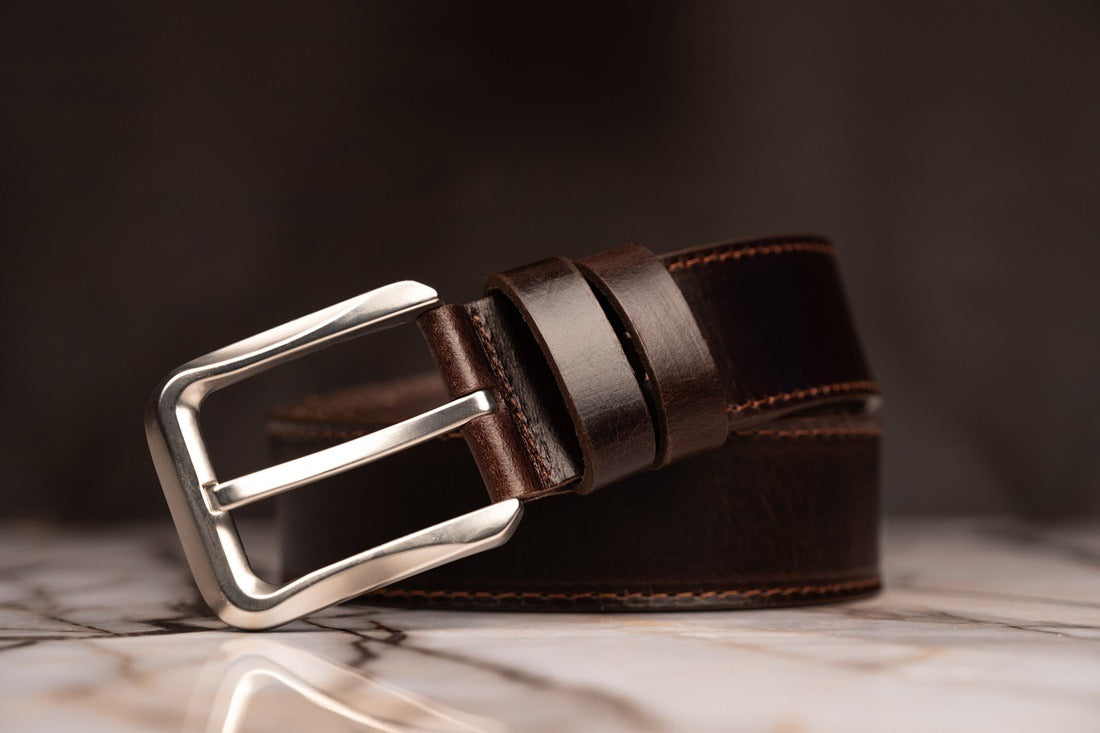Leather belts are timeless accessories that can elevate any outfit, whether you're dressing casually or for a formal occasion. They not only serve a functional purpose but also add a touch of sophistication to your attire. However, like any other leather product, belts require proper care to maintain their beauty and longevity. In this comprehensive guide, we’ll explore essential DIY tips for caring for your leather belt, helping you extend its lifespan while keeping it in pristine condition.
Understanding Leather Types
Before diving into the care tips, it’s crucial to understand the different types of leather used in belts:
- Full-Grain Leather: Known for its durability and natural appearance, full-grain leather belts are made from the top layer of the hide. This type of leather retains the hide's natural texture and markings, giving each belt a unique look. Full-grain leather belts, whether for men or women, are highly sought after for their longevity and ability to age beautifully.
- Top Grain Leather: Slightly lower in quality compared to full grain leather, top grain leather belts are sanded and refinished to remove imperfections. While they are still durable, they may not age as gracefully as full-grain leather.
- Suede Leather: Often mistaken for high-quality leather, genuine leather is actually the lowest grade of leather, made from the layers of the hide that remain after the top layers are split off. Belts made from suede leather are more affordable but less durable.
- Bonded Leather: Bonded leather belts are crafted from leftover leather scraps that are bonded together using adhesives. This process results in belts that are the least durable and most susceptible to wear and tear, making them prone to cracking, peeling, and breaking over time with regular use.
For the purpose of this guide, we'll focus on caring for high-quality leather belts, such as full-grain leather belts, handmade leather belts, and double-thick leather belts, which are known for their strength and durability.
Cleaning Your Leather Belt
Regular cleaning is essential for maintaining the appearance and longevity of your leather belt. Here’s how you can clean your belt at home:
- Dusting Off Debris: Start by gently dusting off any loose dirt or debris with a soft cloth. For belts that are regularly worn as work belts or casual leather belts for men, this step is particularly important to prevent dirt from embedding into the leather.
- Wiping with a Damp Cloth: After removing loose dirt, wipe the belt with a damp cloth. Be sure not to soak the leather; excess moisture can damage it. If your belt is a formal leather belt for men or women, use distilled water to avoid any mineral deposits.
- Using a Leather Cleaner: For deeper cleaning, use a leather cleaner specifically designed for full-grain leather. Apply a small amount of cleaner to a soft cloth and gently rub it into the leather using circular motions. This will help remove stains and restore the belt’s natural shine.
- Drying the Belt: After cleaning, allow the belt to air dry at room temperature. Avoid using heat sources like a hairdryer, as this can dry out the leather and cause cracking.
Conditioning Your Leather Belt
Leather is a natural material that can dry out over time, especially if it’s exposed to sunlight, heat, or moisture. Conditioning your belt regularly will help keep it soft, supple, and resistant to cracking.
- Choosing the Right Conditioner: Select a leather conditioner that is compatible with full-grain leather. Cream-based conditioners are generally recommended as they penetrate the leather more effectively. Using oil-based products can darken the leather so they should be avoided if change of shade is not required.
- Applying the Conditioner: Apply a small amount of conditioner to a clean, soft cloth. Gently rub the conditioner into the belt, focusing on areas that appear dry or cracked. For handmade leather belts, be extra cautious around any stitching or detailing to avoid damaging these elements.
- Letting the Conditioner Absorb: Allow the conditioner to absorb into the leather for at least 15-20 minutes. This gives the leather time to rehydrate and regain its natural oils.
- Buffing the Belt: After the conditioner has absorbed, buff the belt with a clean, dry cloth to remove any excess product and restore its shine. This step is particularly important for formal leather belts for men, as it ensures the belt retains its polished appearance.
Storing Your Leather Belt
Proper storage is crucial for preventing damage and extending the life of your leather belt. Here’s how to store your belt to keep it in the best possible condition:
- Avoid Folding: Never fold your leather belt, as this can cause creases and weaken the leather over time. Instead, store it flat or hang it on a belt rack. If you have limited space, you can gently roll the belt, but be sure not to make the roll too tight.
- Keep Away from Sunlight: Direct sunlight can fade the color of your leather belt and dry out the leather. Store your belt in a cool, dark place to protect it from UV rays. This is especially important for belts like full-grain leather belts, which are prized for their rich, natural color.
- Avoid Moisture and Humidity: Moisture is the enemy of leather. Store your belt in a dry place, away from humid areas like bathrooms. If your belt does get wet, allow it to air dry naturally, and apply a conditioner once it’s dry to restore moisture.
- Use a Dust Bag: For added protection, store your leather belt in a dust bag. This helps shield it from dust, dirt, and scratches. If you own a collection of belts, such as work belts or casual leather belts for men, consider investing in individual dust bags for each belt.
Making a Leather Belt Longer
Over time, leather belts may shrink slightly or you may find that your belt no longer fits as comfortably as it once did. Here are some tips for extending the length of your leather belt:
- Stretching the Belt: To stretch a leather belt, you can gently pull on it while it's still warm from being worn. Alternatively, you can dampen the belt with a little water and then stretch it by hand. Be careful not to overstretch, as this can distort the shape of the belt.
- Adding Extra Holes: If your belt feels too tight, consider adding extra holes. Use a leather punch tool to create new holes, making sure they are evenly spaced and aligned with the existing ones. This method is particularly useful for formal leather belts for men, where a perfect fit is essential.
- Using a Belt Extender: Belt extenders are small accessories that attach to the existing buckle and provide additional length. They are a quick and easy solution for making a belt longer without compromising its appearance.
- Taking It to a Professional: If you’re uncomfortable with DIY methods or if your belt requires significant alteration, consider taking it to a professional leatherworker. They can expertly extend the belt while preserving its integrity and appearance.
Protecting Your Leather Belt
In addition to regular cleaning and conditioning, there are a few extra steps you can take to protect your leather belt from damage:
- Avoid Exposure to Chemicals: Keep your leather belt away from chemicals, including perfumes, lotions, and hair products. These can stain the leather or cause it to dry out.
- Rotate Your Belts: If you own multiple belts, such as a casual leather belt for men and a formal leather belt for men, rotate them regularly. This helps prevent excessive wear on any one belt and extends the lifespan of your entire collection.
- Be Mindful of Buckle Wear: The buckle area is prone to wear and tear, especially on double-thick leather belts. To minimize damage, avoid bending the belt excessively at the buckle and ensure the buckle is always securely fastened.
- Use a Leather Protector: Leather protectors are products designed to add a layer of protection to the surface of the leather. They can help repel water, stains, and dirt, making it easier to care for your belt in the long run.
Conclusion
A well-cared-for leather belt is an investment that can last for years if not decades. By following these DIY tips for cleaning, conditioning, and storing your belt, you can keep it looking as good as new while extending its lifespan. Whether you own a full-grain leather belt for men, a handmade leather belt, or a durable leather work belt, proper care will ensure that your belt remains a stylish and functional accessory for many years to come.
Remember, leather is a natural material that requires regular attention. By taking the time to care for your leather belt, you’re not only preserving its appearance but also honoring the craftsmanship that went into making it. So, the next time you wear your favorite belt, you can do so with the confidence that it will look great and perform well, no matter the occasion.

